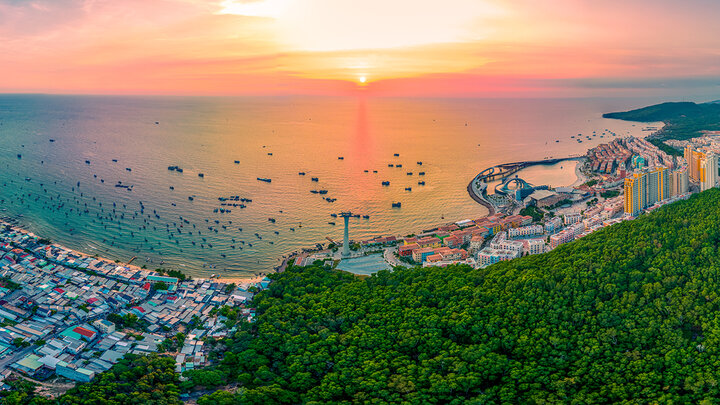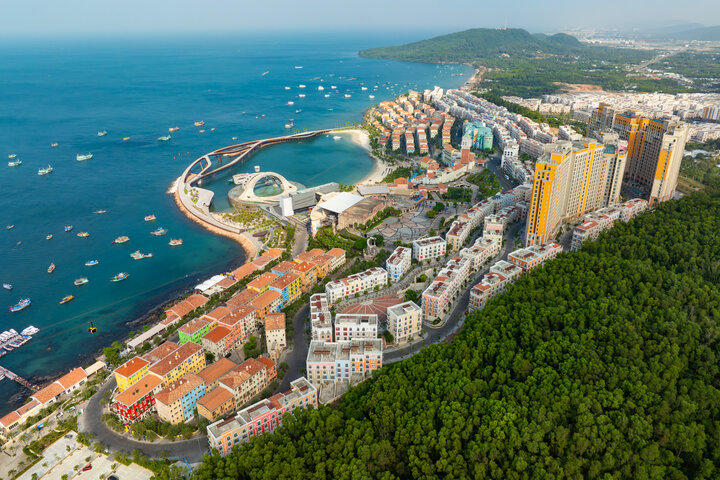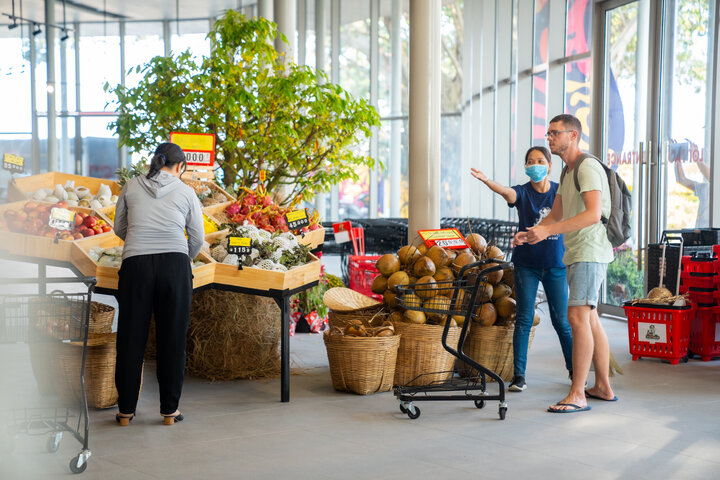Covering almost 31,500 hectares, the park features three distinct forest ecosystems, namely the evergreen broadleaf forest, Melaleuca forest, and mangrove forest. According to the park's official website, it is home to approximately 1,400 plant species and nearly 500 animal species.

Trekking route in Phu Quoc National Park. Photo by Nguyen Anh Tien
Nguyen Anh Tien, a tour guide in Phu Quoc, reveals that trekking through the forest is a relatively new experience that has emerged in the last couple of years, still undiscovered by many tourists. Tien organizes 5-7 tours per month, accommodating groups ranging of up to 12 guests.
Le Minh Tan, a 29-year-old traveler from Ho Chi Minh City, embarked on a 9-kilometer trek in May. The route has distinct paths for the outbound and return journeys, with three stops along the way.
"The trek is relatively easy, with moderate slopes, making it suitable for beginners," Tan said. It took him approximately three hours to reach the destination and around 90 minutes to return.

The mushrooms are bigger than a human hand. Photo by VnExpress/Nguyen Anh Tien
Tan had the time to enjoy gathering and tasting forest fruits like myrtle, fruits and leaves from the garcinia cambogia tree, and mushrooms. Depending on the season, various fruits and leaves can be found.
Aside from mosses, mollusks, fruit trees, and other edible plants, the tour guide introduces visitors to rare and valuable plant species listed in the Red Book, as well as plants whose names are unfamiliar to many.
The trek also unveils a variety of medicinal plants and precious herbs, including ganoderma lucidum, trametes versicolor, and the ant plant.

The ant plant is a precious herb, formed when ants come to live symbiotically on a tree. Photo by Nguyen Anh Tien
The fortunate trekkers may even catch glimpses of wild animals like monkeys, weasels, shrimps, and lizards. Several insects and reptiles, including snakes, centipedes, and lizards, are relatively easier to spot.
Tien highlights that encountering snakes in the forest often triggers panic among many trekkers. In such situations, visitors are advised to remain calm, refrain from chasing or provoking the snakes, and avoid causing harm or attracting attacks. Experienced guides are well-equipped to handle these situations.

A non-poisonous red-tailed green ratsnake is found in Phu Quoc National Park. Photo by Nguyen Anh Tien
The final destination of the trek is Thay Tu Waterfall, measuring approximately 5 meters in height.
Surrounding the waterfall, visitors can find shelter under arched rocks that provide respite from rain and sunlight, doubling as cooking and resting areas.
Adjacent to the waterfall, there is a sinkhole where visitors can capture photographs.

Thay Tu Waterfall is located deep in Phu Quoc National Park. Photo by Nguyen Anh Tien
The water from the waterfall flows into a sizable lake directly beneath, offering clear and refreshing waters.
Visitors can swim, fish, or take photographs. Ample flat rocks in the vicinity are ideal for camping, moon-watching, and stargazing during night time.
"It rained during the trek, and I initially thought luck was not on my side. However, upon reaching the waterfall, the rising water made the spectacle even more impressive," Tan said of his May trip.
To make the most of the trekking experience, Tien suggests that the optimal season is the dry period, spanning from September to February of the following year when rainfall is minimal, yet waterfalls and streams remain abundant, and foliage thrives. Currently, Phu Quoc is in its rainy season; however, visitors can still enjoy trekking, provided they avoid storms or heavy rainfall.
Tien advises visitors to bring sunscreen, bug sprays, long-sleeved clothing, hats, sunglasses, swimwear, sports shoes, and waterproof bags for their phones.
The food is prepared by the guides in advance. Along the trek, visitors have the opportunity to gather mushrooms and wild vegetables, which are then grilled and served.

Shiitake mushrooms found inside Phu Quoc National Park are cooked to serve the visitors. Photo by Nguyen Anh Tien
The park strictly regulates fire usage, hunting, and gathering, necessitating adherence to the guides' instructions.
Visitors are reminded not to litter, refrain from touching animals and plants indiscriminately, and avoid cutting down or removing anything from the forest. Tan's tour guides actively collect and dispose of all waste encountered during the trek.
"Gazing at these green trees, one could hardly believe this is Phu Quoc's forest," Tan mused, as he had previously regarded it as rather boring. He suggests that those familiar with the blue hues of Phu Quoc's seas should venture into the forest to appreciate its greenery, guaranteeing a remarkable experience.


















































